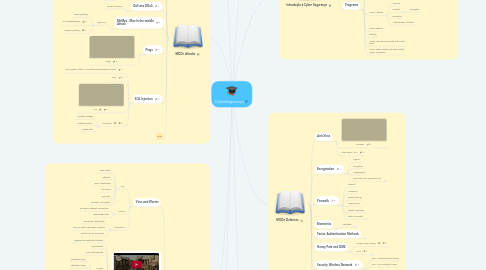
1. MOD2 Mind of a Hacker
1.1. Types Of Hackers
1.1.1. White Hat Hacker
1.1.2. Black Hat Hacker
1.1.3. Grey Hat Hacker
1.1.4. Script Kiddie
1.1.5. Hacktivists
1.1.5.1. Anonymous (group) - Wikipedia
1.1.5.2. WikiLeaks
1.1.5.3. TugaLeaks
1.2. What is not Hacking
1.3. The Hacking Methodology
1.3.1. FootPrinting
1.3.2. Scanning
1.3.3. Enumeration
1.3.4. System hacking
1.3.5. Escalation of privilege
1.3.6. Covering tracks
1.3.7. Planting backdoors
1.4. WhoIS Query DNS
1.4.1. https://lookup.icann.org/
1.4.2. DNS.pt
1.5. Social Engineering
1.6. Quiz
2. MOD3 Attacks
2.1. BFA - Brute Force Attack
2.1.1. Prevention
2.1.2. Password Cracking
2.2. Phishing and Spoofing
2.2.1. Prevention
2.2.2. Email Filtering
2.2.3. Phishing Alerts | FraudWatch International
2.3. Bots and Botnets
2.3.1. Bots and Botnets
2.3.2. Prevention
2.4. DoS ans DDoS
2.4.1. Denial Of Service
2.5. MitMas - Man In the middle Attack
2.5.1. Types OF
2.5.1.1. Email Hijacking
2.5.1.2. WIFI Eavesdropping
2.5.1.3. Session Hijacking
2.6. Pings
2.6.1. Pings
2.7. SQL Injection
2.7.1. SQL Injection Attack - Microsoft Security Response Center
2.7.2. Havij
2.7.3. XSS
2.7.4. Prevention
2.7.4.1. Limited Privileges
2.7.4.2. Software Patches
2.7.4.3. Define Data
2.8. Quiz
3. MOD4 Malware
3.1. Virus and Worms
3.1.1. Virus
3.1.1.1. Flash Drives
3.1.1.2. WebSites
3.1.1.3. Email Attachments
3.1.1.4. Word Docs
3.1.1.5. EXE Files
3.1.1.6. Dorment - File System
3.1.2. Worms
3.1.2.1. By System Network Connections
3.1.2.2. Downloaded Files
3.1.3. Preventions
3.1.3.1. Scan Email Attachments
3.1.3.2. AntiVirus anda AntiMlaware Products
3.1.3.3. Restrict Use of USB Drives
3.2. Trojans
3.2.1. Disguised as Legitimate Software
3.2.2. Sophisticated
3.2.3. Don't Self Replicate
3.2.4. 4 Majors
3.2.4.1. BackDoor Trojan
3.2.4.2. Infostealer Trojan
3.2.4.3. Trojan Downloader
3.2.4.4. Trojan DDoS
3.2.5. Prevention
3.2.5.1. Ant-Malware Products
3.2.5.2. Updates
3.2.5.3. Download only from Trusted Websites
3.3. Adware and Spyware
3.3.1. Adware
3.3.2. Spyware
3.3.2.1. KeyLoggers
3.3.2.2. KeyStrokes
3.3.2.3. ScreenShots
3.3.3. Prevention
3.3.3.1. Free Software not only is free
3.3.3.2. SpyWare Scanners
3.4. RansomWare
3.4.1. 1st AIDS Trojan
3.4.2. Locked Until Payment
3.4.3. Encrypt Files
3.4.4. Turn Other PC's to Botnets
3.4.5. Infects using Email Links and Downloads
3.4.6. RansomWare
3.4.6.1. TorrentLocker - 2014
3.4.6.2. CTB Locker - 2014
3.4.6.3. Locky - 2016
3.4.6.4. WannaCry - 2017
3.4.7. Prevention
3.4.7.1. Backup
3.4.7.2. Turn Off External Applications
3.4.7.3. Never Open Emails Click on Suspicous links
3.4.7.4. AntiVirus
3.5. Other Types Of Malware
3.5.1. Rootkits
3.5.2. Browser Hjacker
3.5.3. Rogue Security Software
3.5.4. Curious
3.6. Quiz
4. MOD6 Information Security at the WorkPlace
4.1. BYOD Management
4.1.1. Risks
4.1.2. BYOD Policy
4.2. MDM - Mobile Device Management
4.2.1. Policy
4.3. Security vs Ease of Acess
4.3.1. Policy
4.4. The dissatisfied employee
5. MOD1 Therminology
5.1. Triad CIA
5.1.1. Confidenciality
5.1.1.1. Limits access to information
5.1.1.2. Ensure Privacy
5.1.1.3. Set Of Rules to limit access
5.1.1.3.1. Methods
5.1.2. Integrity
5.1.2.1. User Access Controls
5.1.2.2. CheckSums
5.1.3. Available
5.1.3.1. Backups
5.1.3.2. Hardware Maintenance and Repairs
5.1.3.3. Disaster Recovery
5.2. Basic Therminology
5.2.1. Blacklist
5.2.2. Whitelist
5.2.3. Cat fishing
5.2.4. Threat
5.2.5. Exploit
5.3. Computer Protocols
5.3.1. What is?
5.3.2. Http and Https
5.3.2.1. Example of HTTP
5.3.2.2. Example of HTTPS
5.3.3. SSL and SSH
5.3.4. FTP and SFTP
5.3.5. IMAP and SMTP
5.4. Cookies
5.5. TCP/IP
5.5.1. 4 Layers
5.5.1.1. DataLink Layer
5.5.1.2. Internet/Networking Layer
5.5.1.3. Transport Layer
5.5.1.4. Application Layer
5.6. Quiz
6. Introdução à Cyber Segurança
6.1. Objectivos
6.2. Competências a Adquirir
6.3. Pré-Requisitos
6.4. Programa
6.4.1. MOD1 Therminology
6.4.1.1. Triad CIA
6.4.1.2. Basic Therminology
6.4.1.3. Computer Protocols
6.4.2. MOD2 Mind of a Hacker
6.4.2.1. Hacking Methodology
6.4.2.1.1. Diferents Types Of Hacking
6.4.3. MOD3 Attacks
6.4.3.1. Brute Force Attack
6.4.3.2. DoS & DDoS Attacks
6.4.3.3. Bots and Botnets
6.4.4. MOD4 Malware
6.4.4.1. Antivirus
6.4.4.2. Firewalls
6.4.4.2.1. Encryption
6.4.4.3. Biometrics
6.4.4.4. Authentication Methods
6.4.5. MOD5 Defence
6.4.6. Phishing
6.4.7. MOD6 Informatiosn Security at the Work Place
6.4.8. MOD7 Cyber Warfare and Cyber Attacks Agains Companies
7. MOD5 Defences
7.1. Anti-Virus
7.1.1. SandBox
7.1.2. PolyMorphic Virus
7.2. Encryptation
7.2.1. Cypher
7.2.2. Decryption
7.2.3. Cryptography
7.2.4. Symmetric and Asymmetric Key
7.2.4.1. Rivest
7.2.4.2. Shamir
7.2.4.3. Adleman
7.2.4.4. DES
7.2.4.5. AES
7.3. Firewalls
7.3.1. Inbound
7.3.2. OutBound
7.3.3. Packet Filtering
7.3.4. Proxy Service
7.3.5. Stateful Inspection
7.3.6. Kind Of Firewalls
7.3.6.1. Hardware
7.3.6.2. Software
7.4. Biometrics
7.4.1. Identifiers
7.4.1.1. Physiological Characteristics
7.4.1.1.1. Fingerprints
7.4.1.1.2. DNA
7.4.1.1.3. Retina
7.4.1.1.4. Face
7.4.1.1.5. Hand
7.4.1.2. Behavioral Characteristics
7.4.1.2.1. Voice
7.4.1.2.2. Gestures
7.4.1.2.3. Gait
7.5. Factor Authentication Methods
7.5.1. 2 Factor Authentication
7.5.1.1. Knowladge Factor
7.5.1.2. Possesion Factor
7.5.1.3. Inherence Factor
7.5.2. Multi Factor Authentication
7.5.2.1. Time
7.5.2.2. Location
7.6. Honey Pots and DMZ
7.6.1. Honey Pot as a Decoy
7.6.2. DMZ
7.6.2.1. Physical
7.6.2.2. Logical
7.7. Security Wireless Network
7.7.1. WEP - Wired Equivalent Privacy
7.7.2. WPA -Wi-Fi Protected Access
7.7.3. WPA2 - Wi-Fi Protected Acces II
7.8. Password Management
7.8.1. Strong Passwords Definiton
7.8.2. Policy Implementation
7.8.2.1. AD
7.8.2.2. Email
7.9. Quiz
8. MOD7 Cyber Warfare and Cyber Attaks Agains Companies
8.1. Examples
8.1.1. DDos - The Attack Against Estonia
8.1.2. The Sony Hack

